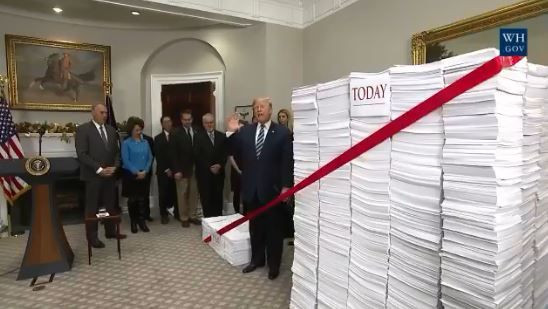Trump Printed Out Every Regulation Created Since 1960, What Were They?

The same day the Federal Communications Commission voted to repeal Obama-era net neutrality legislation, President Donald Trump stood in the Roosevelt Room of the White House next to a large pile of papers. In addition to being an incredibly wasteful use of paper, the 185,000 pages were apparently the regulations that were introduced in the United States since 1960.
The president tweeted in August about all the “regulation ‘busting’” he was working on, including the FCC net neutrality repeal. The stacks of paper the president physically cut red tape off of Thursday are meant to represent regulations, including those that have helped clean the air, water, protected consumers and more over the last nearly 60 years.
“So this is what we have now,” the president said as he pointed to the large stack of paper to his left, “This is where we were in 1960,” he said and gestured to a smaller stack of paper to his right. “And when we’re finished, which won’t be in too long a period of time, we will be less than where we were in 1960 and we will have a great regulatory climate,” he said before grabbing the red tape and cutting it. But what are some of the regulations in that larger stack?
The Clean Air Act
This regulation was introduced in 1970 to regulate emissions that come from both stationary sources like factories and mobile sources like vehicles. In 1990 it was amended with the goal of protecting the ozone layer, reducing the amount of toxic pollutants in the air that can cause acid rain and improving air quality and visibility, according to the Environmental Protection Agency.
Health Insurance Portability and Accountability Act (HIPPA)
The Health Insurance Portability and Accountability Act was adopted in 1996 and protects patient information. “ Prior to HIPAA, no generally accepted set of security standards or general requirements for protecting health information existed in the healthcare industry,” according to the United States Department of Health and Human Services.
Fair Packaging and Labeling Act
This regulation that was passed in 1967 requires that all consumer commodities be labeled to identify the contents of the good, the business that made the product and its location, according to the Federal Trade Commission. This act also authorizes that other regulations that are necessary to prevent any sort of deception of the consumer, like ingredients, can be applied.
Safe Drinking Water Act
The Safe Drinking Water Act was created in 1974 to protect the quality of drinking water available in the U.S from above or below ground sources, according to the EPA. It requires owners or operators of public water systems to comply with the standards to keep water clean that are set by the EPA.
The above acts are just a few of those that were established after the 1960 milestone Trump identified. People in his administration, like EPA chief Scott Pruitt, have tried to repeal other protective acts, such as the Clean Water Rule that was added to the Clean Water Act. Trump himself even signed a bill that ended a rule that the Obama administration instituted on the coal mining industry that protected waterways from harmful waste.
© Copyright IBTimes 2024. All rights reserved.





















